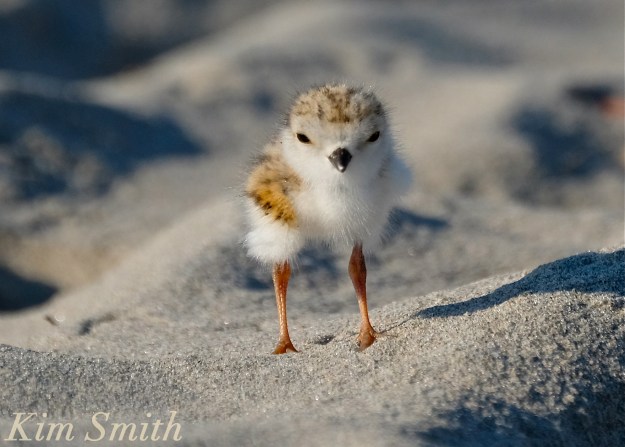Throughout the day, a threesome has been actively feeding, battling for territory, and two of the three, displaying courtship behavior.
Often times I have read that Piping Plovers in Massachusetts do not begin to actively court until mid-April. That simply has not been the case with our Good Harbor Beach pair. As soon as they arrive to their northern breeding grounds, they don’t waste any time and get right down to the business of reproducing! Last year, the PiPls were courting within a week of arriving, and this year, on the first day.
I only had brief periods of time to visit the beach this morning, but within that window, FOUR separate times the male built a little scrape, called Mama over to come investigate, while adding bits of dried seaweed and sticks, and fanning his tail feathers.
 Papa scraping a nest in the sand.
Papa scraping a nest in the sand.
 Fanning his tail and inviting Mama to come inspect the nest scrape.
Fanning his tail and inviting Mama to come inspect the nest scrape.
Tossing sticks and beach debris into the scrape.
Papa high-stepping for Mama.
It was VERY cold and windy both times I stopped by GHB and the PiPls were equally as interested in snuggling down behind a clump of dried beach grass as they were in courting.
Mama and Papa finding shelter from the cold and wind in the wrack line.
Good Harbor Beach was blessedly quiet all day. Our awesome dog officer Teagan Dolan was at the beach bright and early and there wasn’t a single dog in sight, I think greatly due to his vigilance and presence educating beach goers this past week.
 Heather Hall, Katharine Parsons, Alicia Pensarosa, Laurie Sawin
Heather Hall, Katharine Parsons, Alicia Pensarosa, Laurie Sawin
Saturday we had the pleasure of meeting Katharine Parsons, Director of the Mass Audubon Coastal Waterbird Program. She gave an outstanding program to a crowd of Piping Plover advocates and interested parties, which was held at the Sawyer Free Library. Katharine covered everything from life cycle, management strategies and tools, habitat conservation, and the fantastic role Massachusetts is playing in the recovery of Piping Plovers, Least Terns, Roseate Terns, and Oystercatchers. We are so appreciative of Alicia Pensarosa and Gloucester’s Animal Advisory Committee for sponsoring Katharine!
 Ward One City Councilor Scott Memhard and Katharine
Ward One City Councilor Scott Memhard and Katharine
 City Council President Paul Lundberg, Katharine, and Alicia
City Council President Paul Lundberg, Katharine, and Alicia
Fun Fact we learned from Katharine’s presentation–a Piping Plover chick weighs six grams at birth. In comparison, and after consulting Google, a US nickel weighs a close 5.5 grams.

Like this:
Like Loading...




































































































































